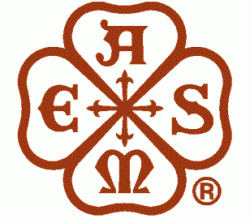ASME A17.3 – 1996 SAFETY CODE FOR EXISTING ELEVATORS AND ESCALATORS
* This document is a guideline for bringing the passenger elevator into compliance with ASME A17.3, 1996 as adopted by the State of Tennessee. This is not an exhaustive list inclusive of every code section. It addresses the most common infractions for the elevator itself. There are code sections dealing with the elevator machine room that are not addressed in this document. For specifics regarding any particular elevator, please contact United Elevator Services for a free survey at 800-338-0064.
CAB DOOR RESTRICTION SYSTEM
ASME A17.3 – 1996 SAFETY CODE FOR EXISTING ELEVATORS AND ESCALATORS. SECTION 2.7.4.
(a) When a car is outside the unlocking zone, the hoistway doors or car doors shall be so arranged that they cannot be opened more than 4 in. (102 mm) from inside the car.
(b) When the car doors are so arranged that they cannot be opened when the car is outside the unlocking zone, the car doors shall be openable from outside the car without the use of a special tool.
(c) The doors shall be unlocked when the car within 3 in. (76 mm) above or below the landing and shall be permitted to be unlocked up to 18 in. (457 mm) above or below the landing.

Folding Door Restrictor
The safest place for a trapped passenger is inside the elevator.
The trapped passenger should use the emergency telephone and/or alarm bell and wait on trained personnel to arrive.
The door restrictor prevents a passenger from opening the interior cab door to get to the exposed hoistway and hoistway doors. There have been cases where the trapped passenger has attempted to free themselves and been killed. Either by falling into the elevator pit or by getting into the hoistway and the elevator restarting and crushing them.
IN-CAR KEY OPERATED STOP SWITCH
ASME A17.3 – 1996 SAFETY CODE FOR EXISTING ELEVATORS AND ESCALATORS. SECTION 3.10.4(t)
In-car Stop Switch. On passenger elevators equipped with non-perforated enclosures, a stop switch, either key operated or behind a locked cover, may be provided in the car located in or adjacent to the car operating panel. The switch must be clearly and permanently marked “STOP” and shall indicate the stop and run positions. The switch shall be positively opened mechanically and its opening shall not be solely dependent on springs. When opened, this switch shall cause the electric power to be removed form the elevator driving machine motor and brake.

TOP-OF-CAR OPERATING DEVICES
ASME A17.3 – 1996 SAFETY CODE FOR EXISTING ELEVATORS AND ESCALATORS. SECTION 3.10.3.
(a) Elevators with automatic or continuous-pressure operation shall have a continuous-pressure button operating switch mounted on the top of the car for the purpose of operating the car solely from the top of the car. The device shall operate the car at a speed of 150 ft/min (0.76 m/s).
(b) The means for transferring the control of the elevator to the top-of-car operating device shall be on the car top and located between the car crosshead and the side of the car nearest the hoistway entrance normally used for access to the car top.

ACCESS TO HOISTWAY
ASME A17.3 – 1996 SAFETY CODE FOR EXISTING ELEVATORS AND ESCALATORS. SECTION 2.7.3(a).
Hoistway door unlocking devices or hoistway access switches shall be provided on elevators having hoistway doors which are unlocked when closed with car at landing, or locked but openable from the landing by means effective only when the car is in the landing zone. Hoistway door unlocking devices may be provided at all landings for emergency purposes.
(a) Hoistway Door Unlocking Devices. Hoistway door unlocking devices shall conform to the following:
- The device shall unlock and permit the opening of the hoistway door from the access landing irrespective of the position of the car.
- The device shall be designed to prevent unlocking the door with common tools.
- The operating means for unlocking the door shall be available to and used only by inspectors, elevator maintenance and repair personnel, and qualified emergency personnel.
- The unlocking-device keyway shall be located at a height not greater than 6 ft, 11 in. (2.11 m) above the floor.
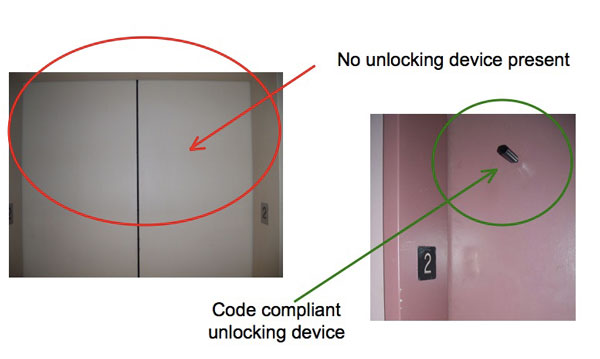
PLATFORM GUARDS (APRONS)
ASME A17.3 – 1996 SAFETY CODE FOR EXISTING ELEVATORS AND ESCALATORS. SECTION 3.3.2.
The entrance side of the platform of passenger elevators and freight elevators shall be provided with smooth metal guard plates of not less than 0.0598 in. (1.519 mm) thick steel, or material of equivalent strength and stiffness, adequately reinforced and braced to the car platform and conforming to the following:
(a) It shall be extended not less than the full width of the widest hoistway door opening.
(b) It shall have a straight vertical face, extending below the floor surface of the platform, of not less than the depth of the leveling, landing, or truck zone, plus 3 in. (76mm). The vertical face shall be a minimum of 21 in. (533 mm), except, where practical limitations do not permit 21 in. (533 mm), the maximum reasonable length shall be provided.
(c) If new guards are installed, the lower portion of the guard shall be bent back at an angle of not less than 60 deg nor more than 75 deg from the horizontal.
(d) The guard plate shall be securely braced and fastened in place to withstand a constant force of not less than 150 lbf (667 N) applied at right angles to and at any portion on its face without deflecting more than 1/4 in. (6.3 mm) and without permanent deformation.
Platform guards are a safety device used to prevent evacuated passengers from falling back into the hoistway upon exiting the elevator cab if it is above floor level.
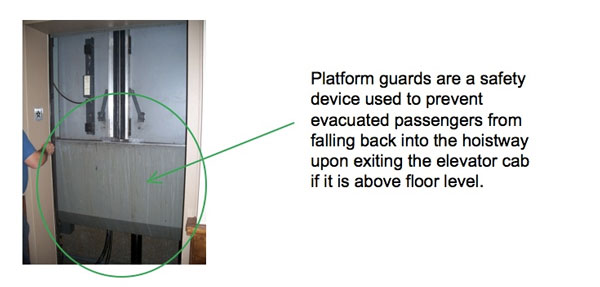
EMERGENCY CAR ILLUMINATION
ASME A17.3 – 1996 SAFETY CODE FOR EXISTING ELEVATORS AND ESCALATORS. SECTION 3.4.5(d).
(d) Passenger elevators shall be provided with a standby (emergency) lighting power source on each elevator conforming to the following
- The standby system shall provide general illumination in the car. The intensity of illumination 4 ft (1219 mm) above the car floor and approximately 1 ft (305 mm) in front of the car-operating device shall be not less than 0.2 ftc (2.2 lx). Lights shall be automatically turned on in all elevators in service immediately after normal car lighting power fails. The power system shall be capable of maintaining the above light intensity for a period of at least 4 h.
- Not less than two lamps of approximately equal wattage shall be used.
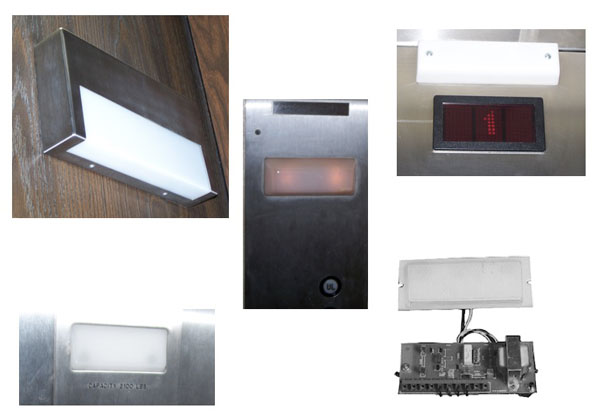
CAR EMERGENCY SIGNALING DEVICES
ASME A17.3 – 1996 SAFETY CODE FOR EXISTING ELEVATORS AND ESCALATORS. SECTION 3.11.1.
Elevators shall be provided with the following signaling devices.
(a) In all buildings, the elevator shall be provided with the following:
- An audible signaling device, operable from the emergency stop switch, when provided, and from a switch marked “ALARM” which is located in or adjacent to each car operating panel. The signaling device shall be located inside the building and audible inside the car and outside the hoistway. One signaling device may be used for a group of elevators.
- Means of two-way conversation between the car and a readily accessible point outside the hoistway which is available to emergency personnel (telephone, intercom, etc.) The means to activate the two-way conversation system does not have to be provided in the car.
- If the audible signaling device, or the means of two-way conversation, or both, are normally connected to the building power supply, they shall automatically transfer to a source of emergency power within 10 s after the normal power supply fails. The power source shall be capable of providing for the operation of the audible signaling device for a least 1 h, and the means of two-way conversation for at least 4 h.
(b) In buildings in which a building attendant (building employee, watchman, etc.) is not continuously available to take action when the required emergency signal is operated, the elevator shall be provided with a means within the car for communication with or signaling to a service which is capable of taking appropriate action when a building attendant is not available.

COUNTERWEIGHT GUARDING
ASME A17.3 – 1996 SAFETY CODE FOR EXISTING ELEVATORS AND ESCALATORS. SECTION 2.1.5.
(a) Un-perforated metal guards shall be installed in the pit and/or machine room located underneath the hoistway on all open sides of the counterweight runway, except that:
- Where compensating chain(s) or rope(s) are attached to the counterweight, the guard may be omitted in the pit on the side facing the elevator car to which these chains or ropes are attached;
- Where pit-mounted buffers are used, the guard may be omitted where the button of the counterweight resting on its compressed buffer is 7ft (2134 mm) or more above the pit floor or above the machine or control room floor if located underneath the hoistway.
(b) Guards shall extend from a point not more than 12in. (305 mm) above the pit floor to a point not less than 7 ft. (2134 mm) nor more than 8 ft. (2438 mm) above such floor, and shall be fastened to a metal frame properly reinforced and braced to be at least equal in strength and stiffness to 0.0747 in. (1,897 mm) sheet metal.
Where hoistway clearances will not permit the installation of counterweight guards, lightweight chains, approximately 24 in (610 mm) in length, shall be attached to the bottom of the counterweight. These chains shall be spaced at 6 in. (152 mm) intervals to provide a warning to a person in the path of the descending counterweight.
(c) If the counterweight extends into a machine or control room underneath the hoistway, guards shall be provided as required by 2.1.5(b).


ACCESS TO PITS
ASME A17.3 – 1996 SAFETY CODE FOR EXISTING ELEVATORS AND ESCALATORS. SECTION 2.3.1.
(a) Means of access for authorized personnel shall be provided to all pits.
(b) Where a separate pit access door is provided, it shall be self-closing and provided with a spring-type lock arranged to permit the door to be opened from inside the pit without a key. Such doors shall be kept locked.
(c) Keys to unlock the pit access door shall be kept on the premises in a location readily accessible to authorized personnel, but not where the are accessible to the general public. The keys shall be permitted to be the same as those used for the machine room access door.

PIT STOP SWITCH
ASME A17.3 – 1996 SAFETY CODE FOR EXISTING ELEVATORS AND ESCALATORS. SECTION 2.3.3.
A stop switch conforming to the requirements of 3.10.4(e) shall be provided in the pit of every elevator. The switch shall be located adjacent
to the normal pit access.
3.10.4(e) Stop Switch on Top of Car. A stop switch shall be provided on top of every elevator car, which shall cause the electric power to be removed from the elevator driving machine motor and brake; and
- Be of manually operated and closed type;
- Have red operating handles or buttons;
- Be conspicuously and permanently marked “STOP” and shall indicate the stop and run positions;
- Be positively opened mechanically (opening shall not be solely dependent on springs).

EMERGENCY EXITS
ASME A17.3 – 1996 SAFETY CODE FOR EXISTING ELEVATORS AND ESCALATORS. SECTION 3.4.4.
(a) Top Emergency Exits
- For elevators installed in enclosed hoistways, cars shall be provided with a top emergency exit with a cover hinged or otherwise attached to the car top so that the cover can be opened from the top of the car only and opens outward.
- For multideck elevator cars, the exit cover of the lower compartment shall be openable from either compartment.
- For elevators installed in unenclosed hoistways:
- (a) Top emergency exits shall not be installed in cars in an unenclosed hoistway. Existing top emergency exits shall be permanently secured closed.
- (b) Where an elevator is installed in a single blind hoistway, there shall be installed in the blind portion of the hoistway an emergency door at every third floor, but not more than 36 ft (10.97 m) from sill to sill conforming to the following:
- The clear opening shall be at least 28 in . (711 mm) wide and 6 ft 6 in. (1981 mm) high.
- It shall be easily accessible and free from fixed obstructions.
- It shall be either of the horizontal sliding or swinging single-Section type, irrespective of the type of door installed at other landings.
- It shall be self-closing and self-locking and shall be marked, in letters not less than 2 in. (51 mm) high, “DANGER, ELEVATOR HOISTWAY.”
- It shall be provided with an electric contact conforming to the requirements of 2.7.5.
- It shall be unlocked from the landing side only through the use of a cylinder-type lock, having not less than a five-pin or five-disk combination. The cylinder shall:
- not be unlocked by any key or combination which will open any other lock or device used far any purpose in the building;
- be so designed that the key shall be removable only in the locked position.
- The key combination shall be kept where it is available only to authorized persons.
(b) Side Emergency Exits. Side emergency exit doors or panels, where provided, shall have a lock arranged so that the door may be opened from the inside of the car only by a special shaped removable key and outside the car by means of a non-removable handle. All side emergency car exits shall be equipped with electric contacts to prevent the movement of the car if the exit door or panel is not closed. Side emergency door panels shall open only into the car.
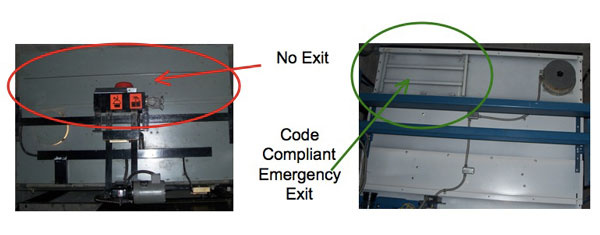
CAPACITY PLATES
ASME A17.3 – 1996 SAFETY CODE FOR EXISTING ELEVATORS AND ESCALATORS. SECTION 3.7.4.
(a) Every elevator shall be provided with a capacity plate permanently and securely fastened in place and located in a conspicuous position inside the car. It shall indicate the rated load of the elevator in pounds, and for freight elevators, this plate or a separate plate shall indicate:
- the capacity for lifting one-piece loads;
- for freight elevators used for industrial truck loading where the truck is not usually carried by the elevator but used only for loading and unloading, the maximum load the elevator is designed to support while being loaded or unloaded.
(b) Capacity plates shall be durable and readily legible. The height of the letters and figures shall be not less than:
- 1/4 in. (6.3mm) for passenger elevator capacity plates;
- 1 in. (25mm) for freight elevator capacity plates.


